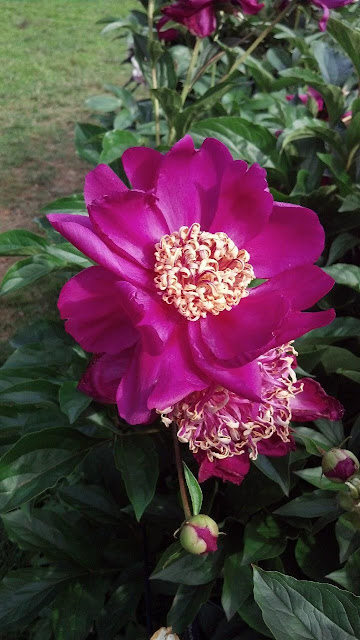
|
Peonies are beautiful, self-sufficient flowers.
(Photo: Debbie Arrington)
|
Keys to success with this favorite flower
One flower made me fall in love with gardening in Sacramento: The peony.
As a Northern California transplant, I marveled at these gigantic blooms that seemed to emerge out of nowhere each spring. Even more amazing was how easy they were to grow. Totally ignored, they put on a spectacular show, year after year, delivering a surprise bouquet in April or May.
Peonies are practically nonexistent in my native Long Beach. Although coastal SoCal is perfect for growing many things that can be problematic for the Central Valley (think avocados, bougainvillea, Mexican limes), Sacramento has what most beach towns lack: Winter chill.
Peonies generally need about 400 chill hours each winter in order to produce blooms. (More on chill hours Tuesday.) Sacramento reliably gets 600-plus chill hours; some areas close to 800.
Chill hours help peonies “go to sleep.” The plants lose all their foliage and die back to the ground. That dormancy allows them to conserve energy for their spring spectacular.
This disappearing act makes them very difficult to find in the garden – especially if they weren’t marked. So, now is the time to plant, move or divide peonies.
Peonies, which can live generations, are among the world’s oldest cultivated flowers, dating back at least 6,000 years. Although very self-sufficient, they need to be divided every decade or so, then promptly replanted or potted. The good part: This process revitalizes the plant and produces a lot more peonies.
September is ideal for this process. The soil is still warm enough to stimulate root development, and the peonies still have some foliage above ground. They can be spotted.
To divide, cut back the foliage to about 4 inches tall. Gently lift the whole clump out of the soil. Set aside and gently wash off soil with a hose or submerge the clump in a large pail of water.
That exposes the peony’s odd root system. The main tap roots will be dark brown and topped by a crown with distinctive red or white “eyes” (the beginnings of next year’s flowers). Off those main roots will be fleshy tan tubers (future peony makers) and thin hairlike rootlets. The tubers tend to break off easily, so treat them with care. Gloved fingers are your best tool.
Now, here’s the peony paradox: After years of undisturbed growth, the tap roots squeeze each other, fighting for space. That starts to diminish bloom number and size. But peonies thrive on crowded conditions; a little bunching creates big, rounded, mounded displays.
So, when dividing peonies, keep at least three to five eyes in each new clump. Those eyes may not all be on one tap root. More eyes, more blooms and the faster the new plant forms its own full mound. Also, each tap root needs at least some crown to survive and bloom.
Clumps tend to have natural dividing lines where the tangled roots can be pried apart easily or cut with a sharp knife. Keep the tubers attached, but trim off the little rootlets. (According to peony experts, those rootlets can be the source of root-borne diseases, causing the baby plants to die.) Also trim off any remaining foliage.
Replanting comes next. Choose the right location. Peonies need at least six hours of sun a day for consistent bloom. In Sacramento, they prefer morning sun and light afternoon shade (it helps the fragile blooms last longer). Before planting, work 1/4 cup bone meal into the soil for each new clump. Plant the clump with the eyes pointing up, an inch or two below soil level (but no deeper) and the tap root pointing down. Gently smooth soil over the clump and water deeply. Mark the spot with a stake or other reminder. Then, wait.
Peonies in pots may need occasional watering in winter, but in the ground, they’re pretty self-sufficient. They’re easy to plant and forget.
In March or April, new foliage will start to appear. If you forgot where they were, peonies in spring are much easier to find.

